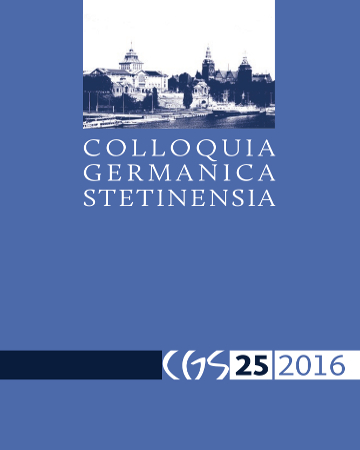







| Authors: |
Małgorzata
Osiewicz-Maternowska
Uniwersytet Szczeciński, Wydział Filologiczny |
| Keywords: | null-subjekt Transformational Generative Grammar Dependency Verb Grammar |
| Data publikacji całości: | 2016 |
| Page range: | 13 (379-391) |
| Downloads ?: | 626 |
| 1. | Bąk, Piotr. Gramatyka języka polskiego. Warszawa: Wiedza Powszechna, 1984. |
| 2. | Fillmore, Charles. J. „The case for case“. In: Universals in Linguistic Theory, hrsg. v. Emmon Bach, Robert T. Harms, 1–88. New York, 1968. (Dt. Übersetzung: „Plädoyer für Kasus“. In: Kasustheorie, hrsg. v. Werner Abraham, 1–118. Wiesbaden: Aula-Verlag, 1977. |
| 3. | Järventausta, Marja. Das Subjekt im Deutschen und im Finnischen: seine Formen und semantischen Rollen. Frankfurt a. M.: Peter Lang, 1991. |
| 4. | Jung, Walter. Grammatik der deutschen Sprache. Leipzig: Bibliographisches Institut, 1988. |
| 5. | Klemensiewicz, Zenon. Zarys składni polskiej. Warszawa: PWN, 1963. |
| 6. | Mazurkiewicz-Sokołowska, Jolanta. Lingwistyka mentalna w zarysie. O zdolności językowej w ujęciu integrującym. Kraków: Universitas, 2010. |
| 7. | Mecner, Paweł. „Zur Bindung von Anaphern und NPs. Eine G- & B-Analyse Deutsch – Polnisch“. Linguistica Silesiana Vol. 17 (1997): 65–81. |
| 8. | Nagórko, Alicja. Zarys gramatyki polskiej. Warszawa: PWN, 1998. |
| 9. | Oppenrieder, Wilhelm. Von Subjekten, Sätzen und Subjektsätzen: Untersuchungen zur Syntax des Deutschen. Tübingen: Max Niemeyer Verlag, 1991. |
| 10. | Osiewicz-Maternowska, Małgorzata. „Zur Anapher in Chomskys Sinn in anderen als generatives Klassifikationssystemen“. Colloquia Germanica Stetinensia 22 (2013): 215–231. |
| 11. | Pilarski, Anna. Die Operation Merge im Verbalkomplex des Polnischen und des Deutschen. Frankfurt a. M.: Peter Lang, 2002. |
| 12. | Pilarski, Anna. „Zu Pro-drop-Eigenschaften im Polnischen und im Deutschen“. Kwartalnik Neofilologiczny 3/03 (2003): 355–371. |
| 13. | Pilarski, Anna. „Über die strukturellen Konfigurationen der Subjekt-NP im Polnischen und Deutschen“. Convivium 2004 – Germanistisches Jahrbuch Polen (2004): 301–324. |
| 14. | Pilarski, Anna. „Zum Quantor in der Kongruenzphrase im Deutschen und im Polnischen“. Sprachtheorie und germanistische Linguistik. Eine internationale Zeitschrift 15. 2 (2005): 153–188. |
| 15. | Pilarski, Anna. „Zum Minimalistischen Programm des Kasus im Deutschen und im Polnischen“. Colloquia Germanica Stetinensia 15 (2006): 99–124. |
| 16. | Pilarski, Anna. Das Nullsubjekt im Polnischen. Dependenzielle Verbgrammatik und Generative Transformationsgrammatik im Modellvergleich. München: IUDICIUM, 2013. |
| 17. | Reis, Marga. „Zum Subjektbegriff im Deutschen“. In: Satzglieder im Deutschen. Vorschläge zur syntaktischen, semantischen und pragmatischen Fundierung, hrsg. v. Werner Abraham, 171–211. Tübingen: Gunter Narr Verlag, 1982. |
| 18. | Schendels, Evgienija. Deutsche Grammatik. Moskau 1979. |
| 19. | Schulz, Dora, Heinz Griesbach. Grammatik der deutschen Sprache. München: Max Hueber Verlag, 1990. |
| 20. | Strutyński, Jan. Gramatyka polska. Kraków: Tomasz Strutyński, 1999. |
| 21. | Vater, Heinz. „Pronominantien“ – oder: Pronomina sind Determinantien“. In: Deutsche Grammatik in Theorie und Praxis, hrsg. v. Rolf Thierhoff, Martin Tamrat, Nanna Fuhrhop, Oliver Teuber, 185–199. Tübingen: Max Niemeyer Verlag, 2000. |
| 22. | Vogelsang-Doncer, Agnieszka. „Über Definitionsversuche des Subjektbegriffs“. In: Phänomene im syntaktisch-semantischen Grenzbereich, hrsg. v. Lesław Cirko, Martin Grimberg, 205–220. Dresden, Wrocław: Neisse Verlag, 2006. |